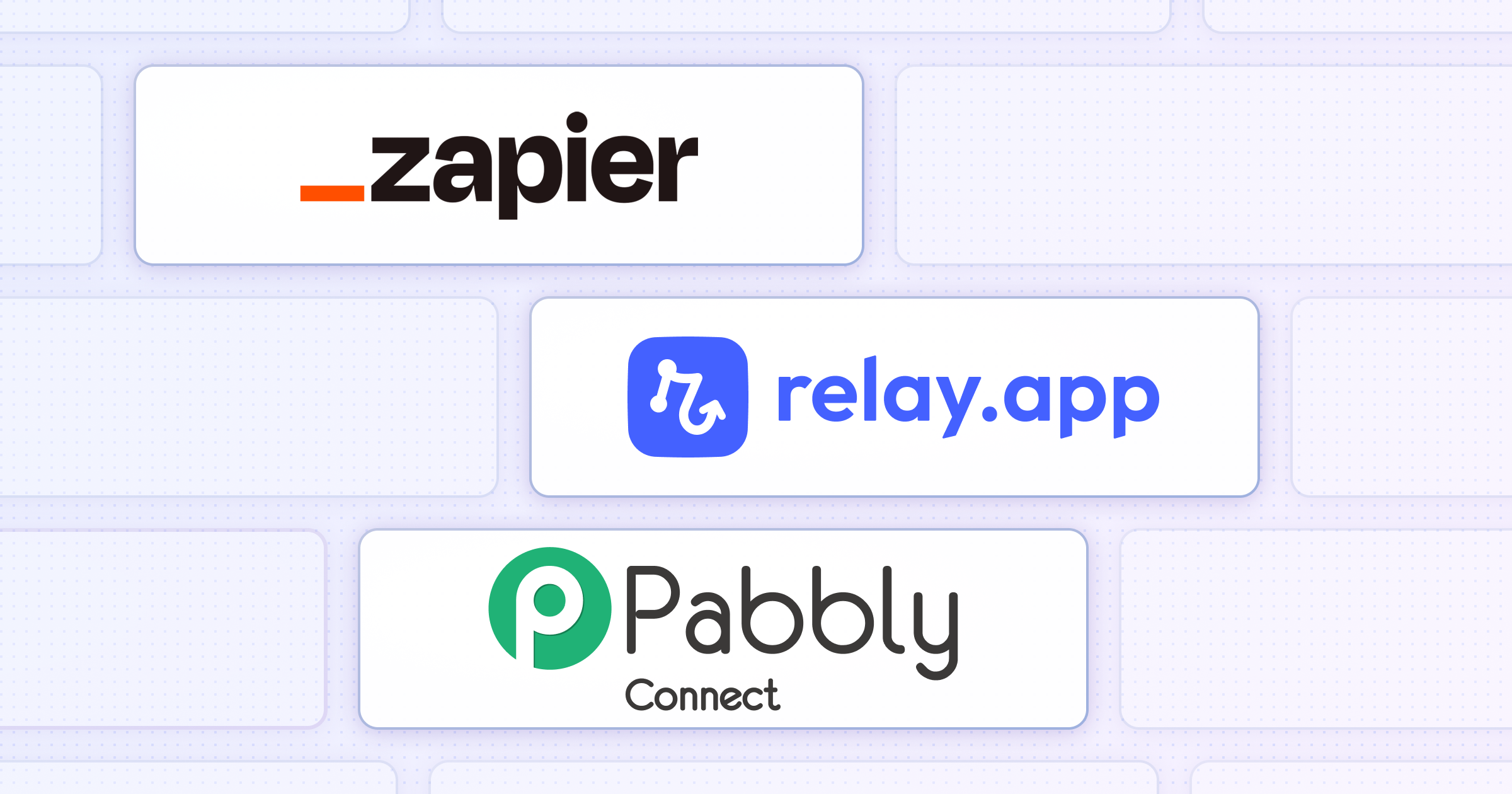
Pabbly Connect, Zapier, and Relay.app are all solid no-code workflow automation tools with unique ways of connecting apps and automating tasks.
How do you choose the best one for your needs?
Well, your ideal choice will be based on affordability, extensive integrations, and innovation.
To help you make an informed decision we compared Pabbly Connect and Zapier with our tool (Relay.app).
Here’s what we found:
Relay.app is perfect for users who want to add personalization to automated workflows (human-in-loop), collaborate with teams, and run large volumes of automation at a low cost.
Zapier excels in its extensive integration library, multistep automation, and custom workflows.
Pabbly Connect is affordable and suits teams with simple processes.
To arrive at this conclusion, we conducted an in-depth comparison of the tools including their features, integrations, costs, and customer reviews.
If you want to jump straight into exploring Relay.app's innovative features, Sign up here to check it out.

Features - Pabbly Connect vs Zapier vs Relay.app
All three tools are powerful automation tools with their own unique strengths.
Let's start by comparing their key features:
Relay.app's features
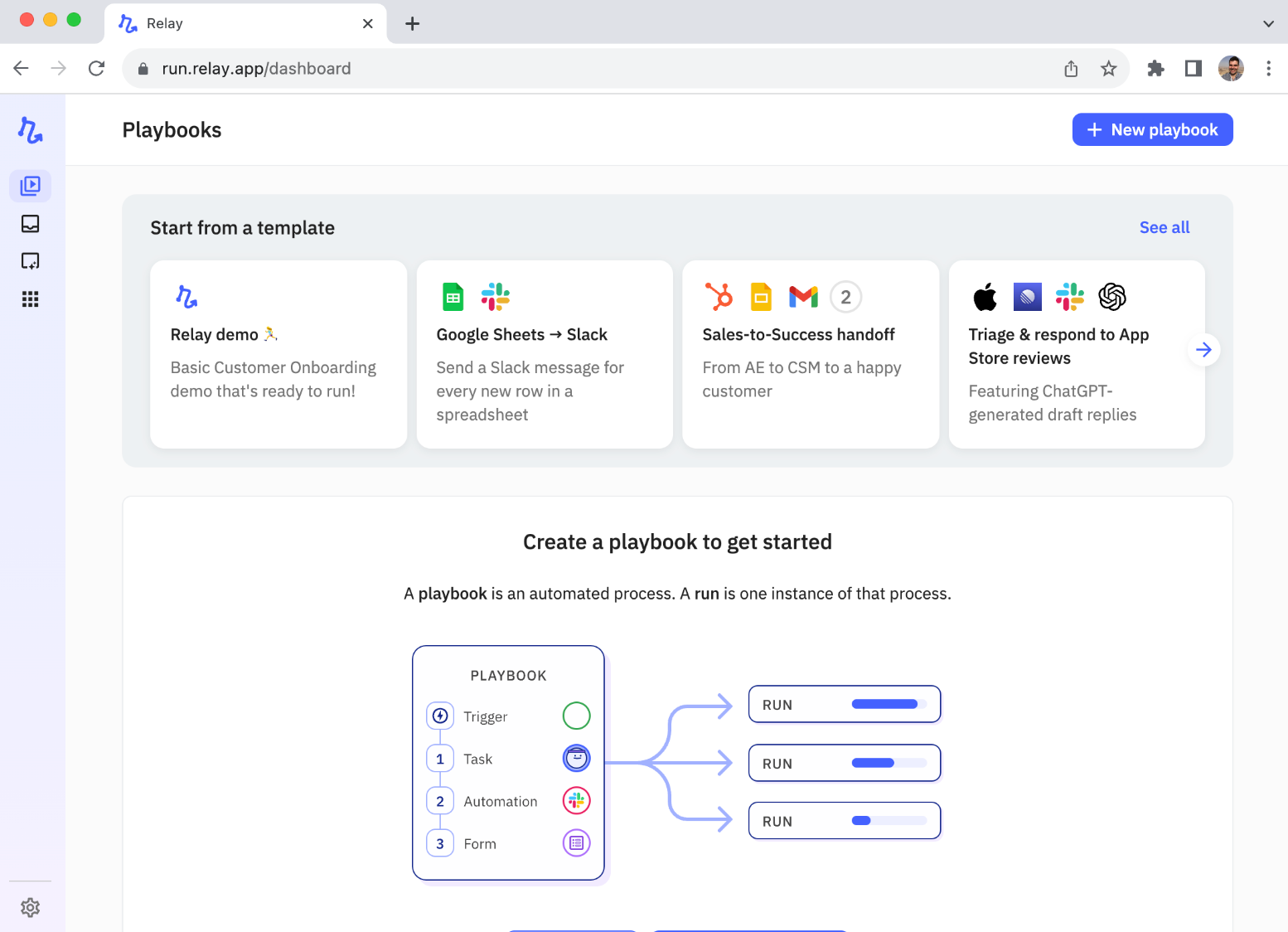
One of our users, Hassan Raza, CEO of Tavus said, “Relay.app is the only tool we've used that conforms to our processes, rather than having the processes to conform to the tool”.
This speaks volumes about Relay.app's user-friendly interface and ability to run workflows using customizable playbooks.
Relay.app integrates natively with modern apps across engineering, marketing, sales, and support, offering unique features beyond the basic capabilities found in Zapier and Pabbly Connect.
Three features that stand out in Relay.app are “Human in the loop”, “AI autofill”, and “Collaborative workflow automation”.
Human in the loop
It’s better to be cautious about automating specific tasks for business processes.
For example, workflows where human input can lead to better outcomes, like personalizing a customer interaction or giving approval.
However, that doesn't mean forfeiting the advantages of automating your workflows.
Relay.app’s human-in-the-loop feature helps you combine automation and human judgment, or, more precisely, add human actions to automated workflows.
With this feature, you can run automated workflows that stop when you need to add human input.
🚀 It saves time for fully automated steps.
🎯 And ensures quality with human steps.
To help you understand the nuances, here are four situations where human-in-the-loop proves invaluable during automations:
Review/approval: Engage humans for tasks requiring a specific standard of quality or accuracy.
For example, in an expense automation process, you can ask a team member to verify transaction details before they’re automatically logged in QuickBooks.
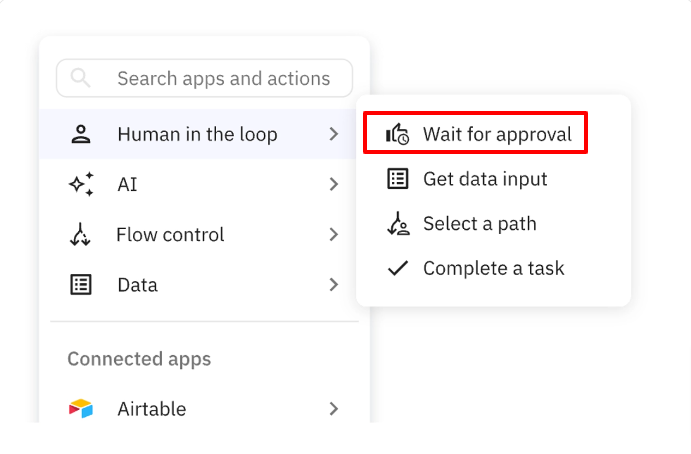
Complex decision-making: Unexpected situations can arise that an automated system isn't equipped to handle, such as anomalies in data processing.
With a human in the loop, you can have an expert review and decide how to address exceptions.
For example: accountants review transactions flagged by your payment system for potential fraud.
In Relay.app, you can change the workflow’s path based on a human’s decision, like your accountant deciding that the transaction is indeed fraudulent.
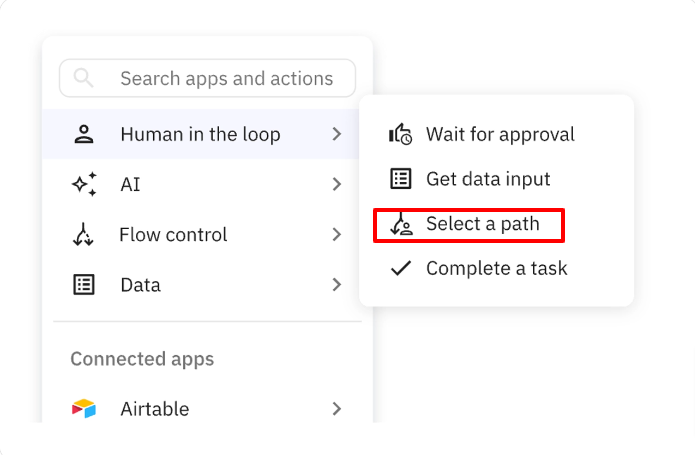
Sensitive decisions: When decisions require careful consideration of ethical, cultural, or legal implications, you can incorporate a human step in the workflow.
This ensures that decisions align with your organization's values and comply with regulations.
For instance, automated systems can screen resumes in a recruitment workflow, but final screening decisions often require human input to ensure fair and unbiased selection.
Task completion: In a marketing automation workflow, AI can generate emails based on target customers' purchase history. For high-value clients, however, you can add a personalized touch.
Account managers can take the auto-generated draft, optimize it to align with client preferences, and recommend tailored products and offers. This means an improved customer experience and increases the chance of sales.
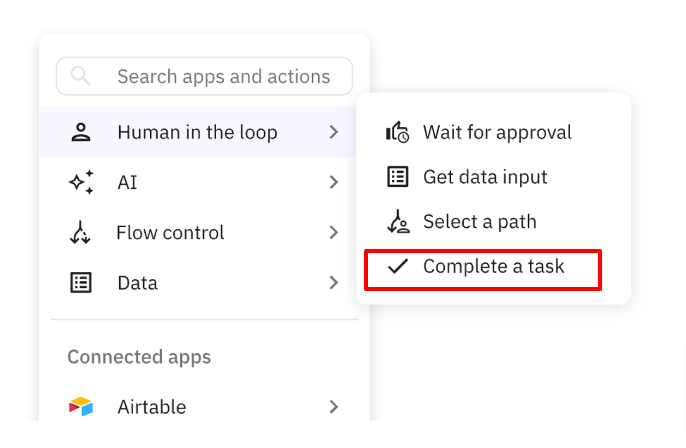
AI autofill
Relay.app offers a native AI autofill feature that lets you populate fields automatically so that workflows run smoothly with minimal involvement from your team. Try it ⤵️
This enables you to extract data and summarize resources based on your desired length without prompts. Here are some examples of what you can achieve with AI autofill in various scenarios:
Customer record updates: Automatically extract key information from customer interactions such as call transcripts, and update customer records in your CRM.
Data entry automation: Extract data from documents such as invoices, receipts, or forms and automatically input the data into the relevant fields in your spreadsheet.
Personalized outreach: Extract contact information and details from meeting invites or online forms, such as job titles, and use them to personalize emails with potential clients.
Content creation: Summarize articles, reports, or other content for sharing with team members or clients.
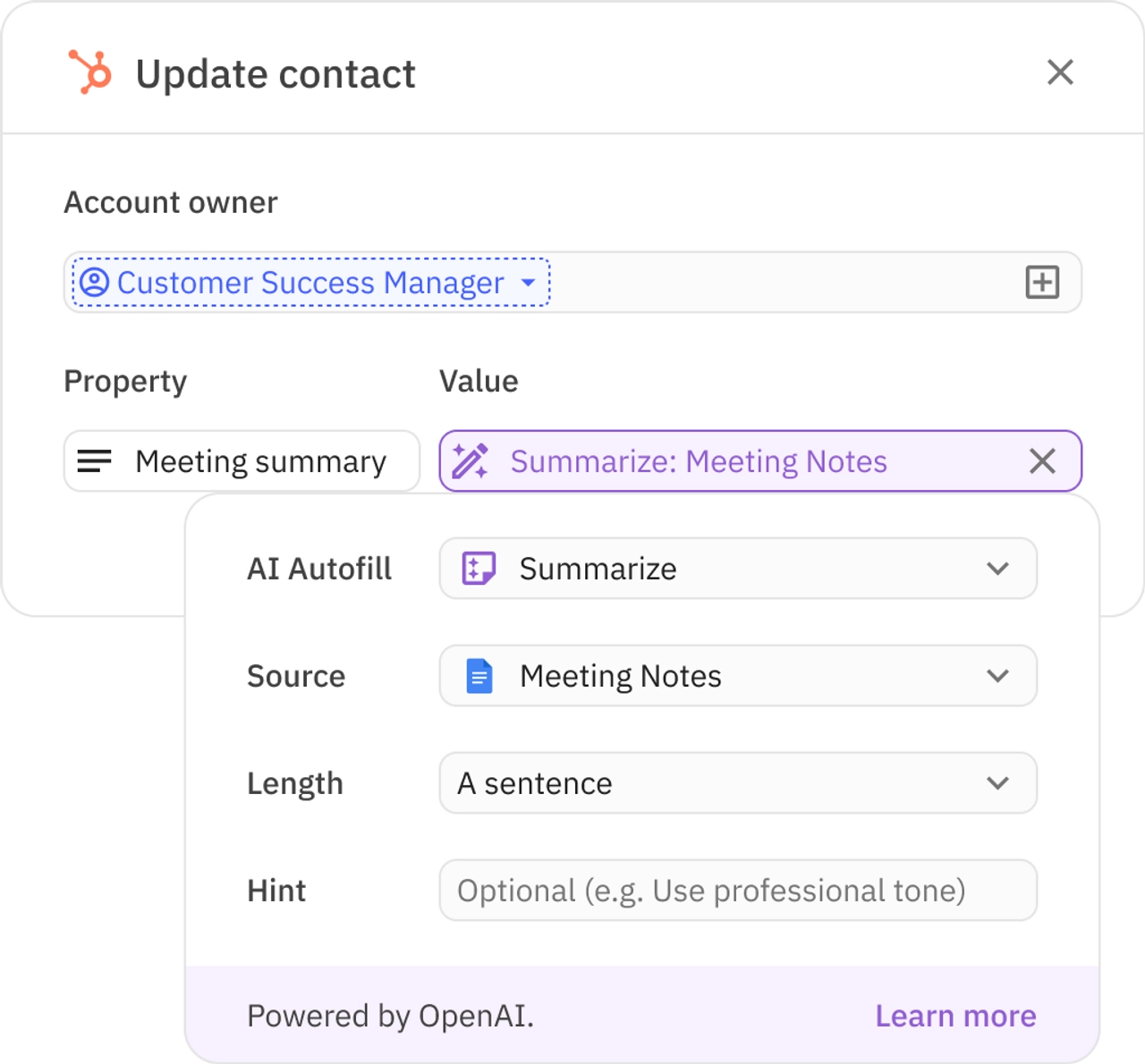
These examples demonstrate how AI autofill can streamline automation processes by reducing manual data entry while enhancing the accuracy and efficiency of workflows.
Collaborative workflow automation
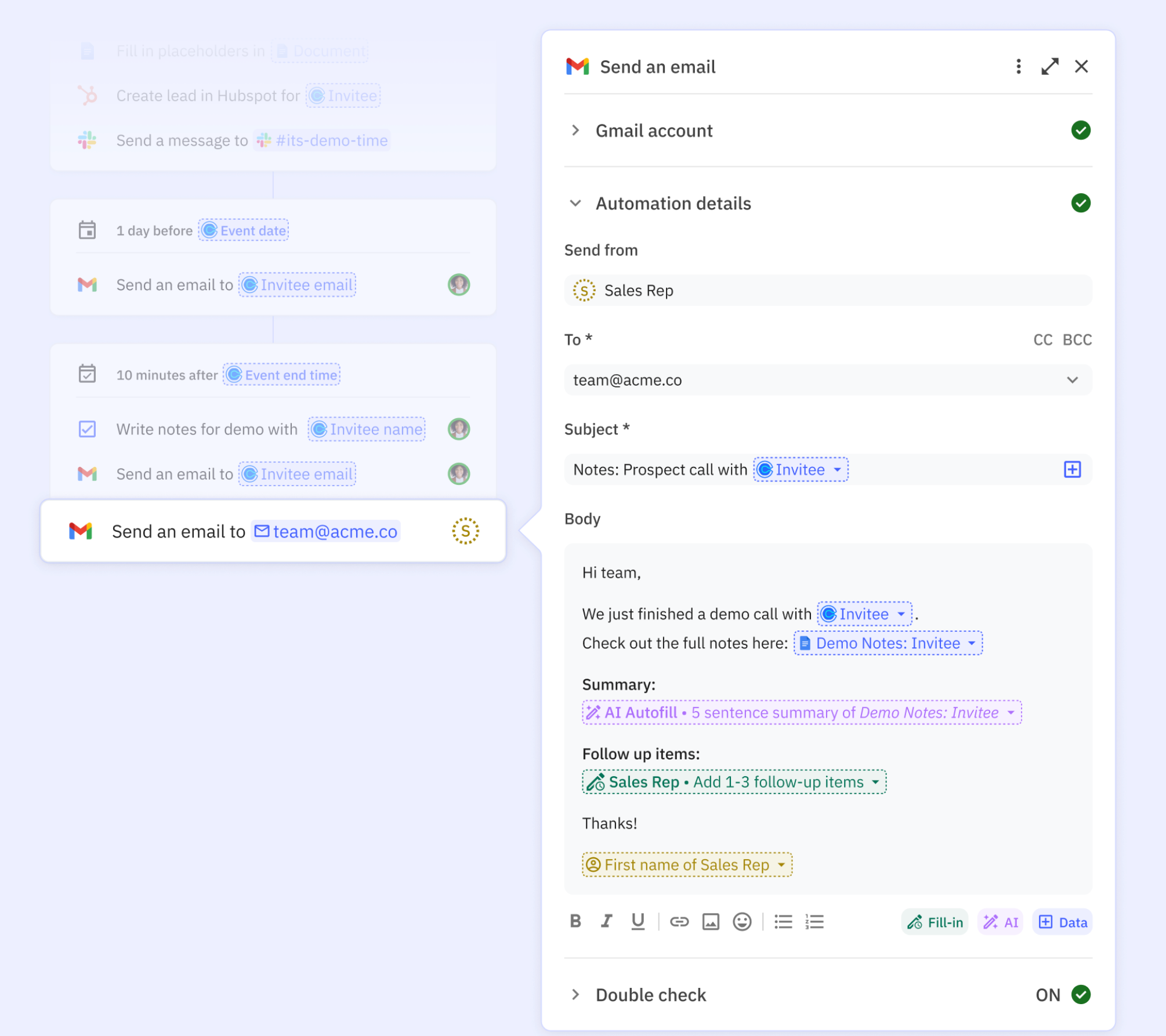
Whether your team is small or large, and regardless of their technical expertise, Relay.app is here to support collaborative workflows that promote transparency, efficiency, and inclusivity.
Here's how Relay.app can empower your team:
Collaborative playbook creation and editing: Add your team members to your Relay.app account as collaborators so they can create a playbook from scratch or edit by adding or deleting steps, or changing conditions.
Human personalization: If you need to add human insight to your task, use the @ button to assign tasks to specific team members.
Approval: In a step that needs quality control, you can delegate a team member, based on their role, to review and approve the task.
Zapier’s features
As the earliest and most popular workflow automation tool, Zapier has amassed a wealth of features and integrations. Let's explore some of its standout capabilities.
Multistep and custom workflow
Zapier's multi-step workflows let users chain together a sequence of triggers and actions, enabling the creation of complex workflows.
Users also have access to filters, conditions, and logic for enhanced customization. This means you can create customizable workflows called “zaps” that execute specific actions based on precise criteria, resulting in more targeted and efficient automation.
While Relay.app and Pabbly Connect offer similar capabilities, Zapier's integration with a wide range of applications and its rich path rules give its multi-step and custom workflow the upper hand.
Multiple ways to build zaps
Zapier offers various methods for building zaps, providing flexibility and options to suit your preferred workflow creation approach. You can build multi-step zaps using:
- Visual workflow builder by dragging and dropping

- AI assistant by describing your workflow in plain text
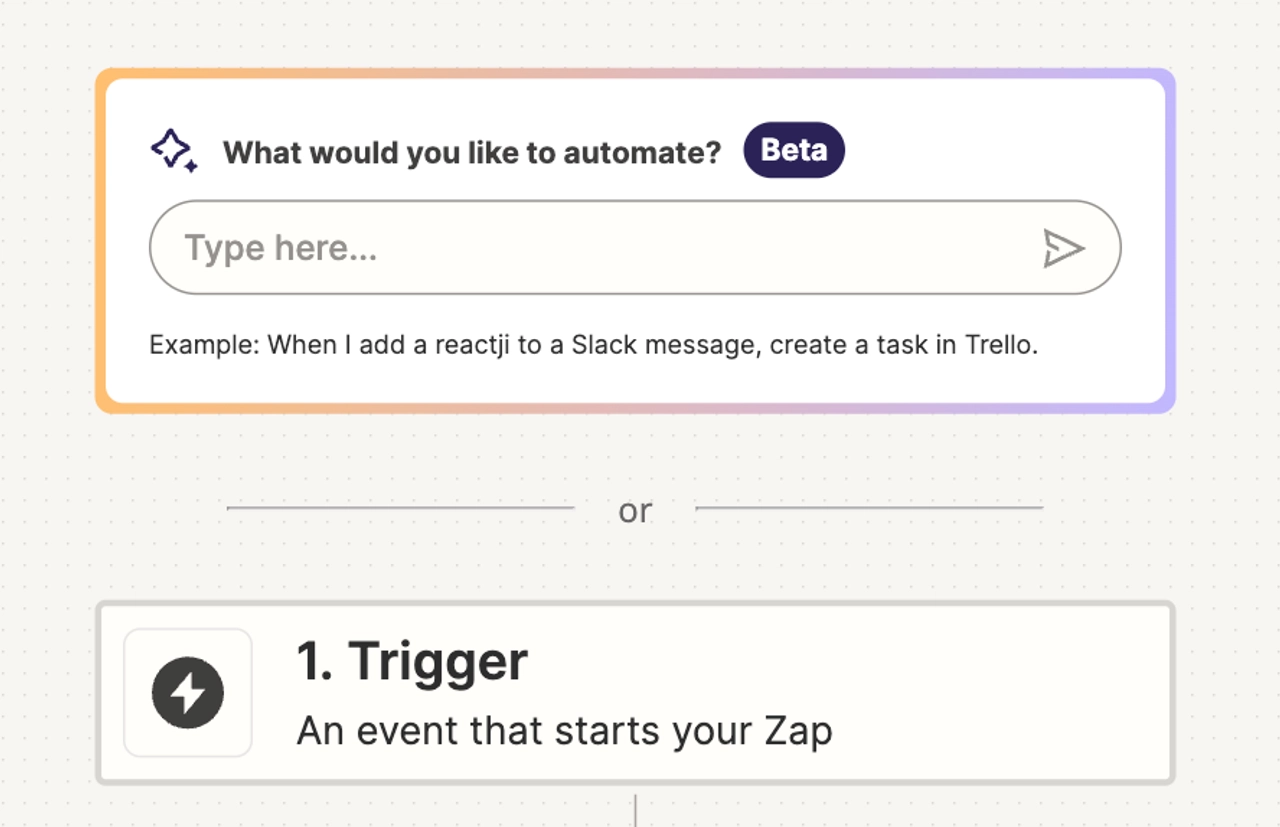
- Prebuilt templates for simple workflows
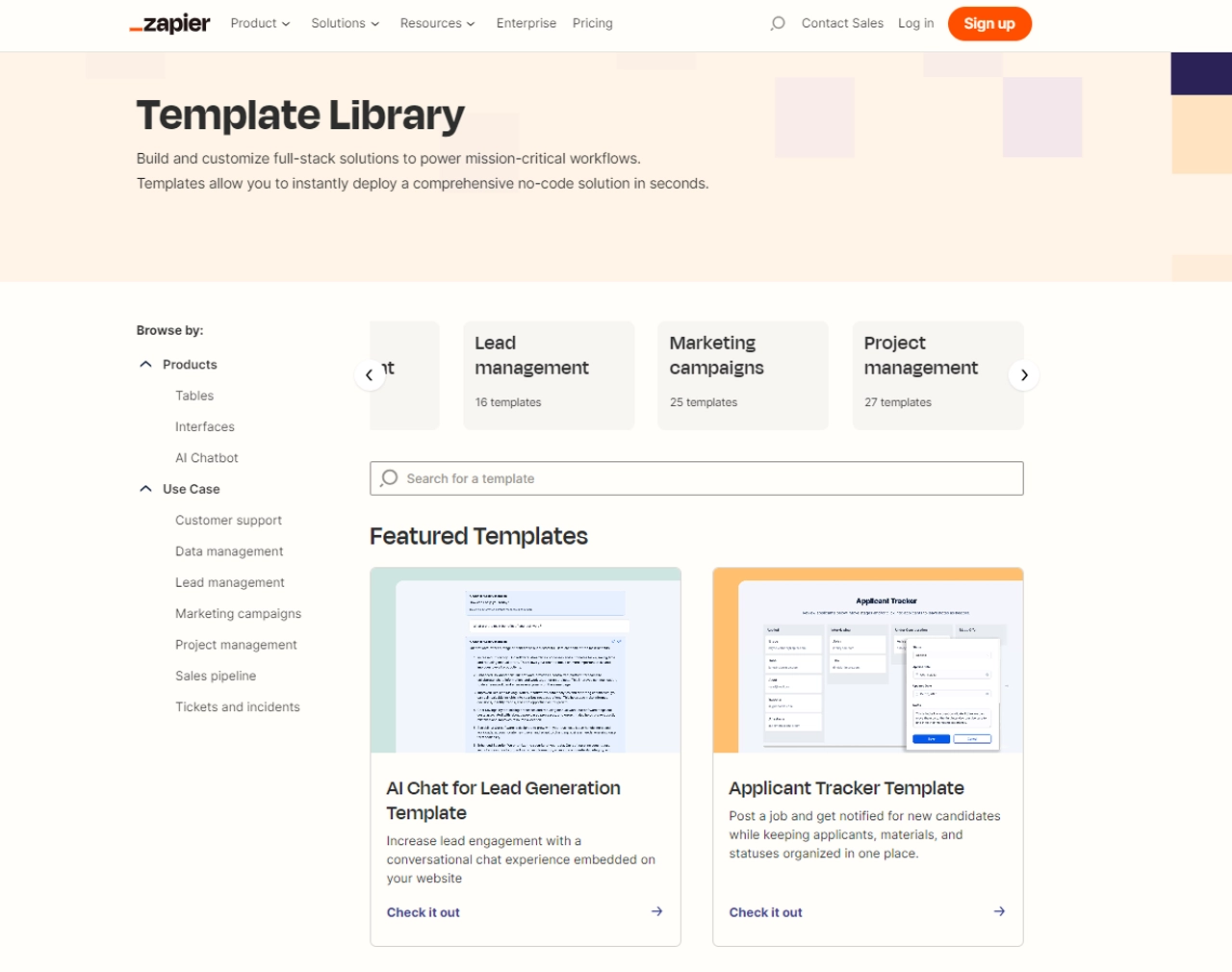
- Search and select from app library
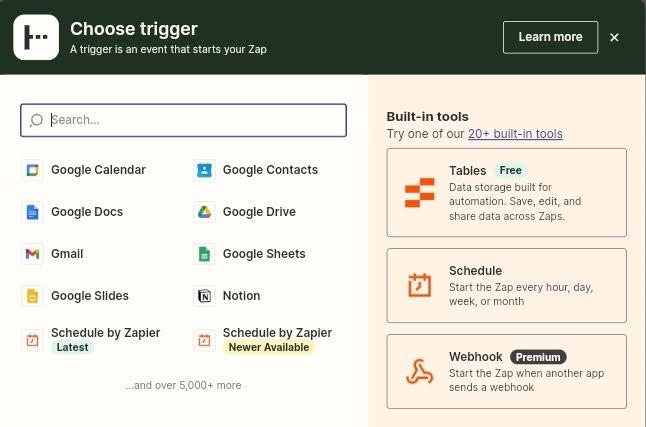
Tables

Zapier offers Tables, a database tool that enables users to create, manage, and automate data-centered workflows. With tables, you can:
- Compare data across apps
- Streamline onboarding processes
- Create and automate lead management tables
Tables are integrated into Zapier's automation platform, making it easy to connect with other apps and automate seamlessly.
Pabbly Connect’s features
Pabbly Connect is one of the most budget-friendly tools you’ll find in the automation space.
Here's an overview of Pabbly Connect's key features:
Workflow builder

Pabbly Connect's intuitive workflow builder lets you visually create workflows without coding knowledge.
Users can design trigger events, action steps, or filters to automate repetitive tasks. For instance, in the example above, you can use AI to create automatic replies whenever someone leaves a review on your Google My Business page.
Pabbly Connect also has a product tutorial library that offers detailed instructions on creating and optimizing automation workflows.
Workflow scheduler

Workflow schedulers empower users to schedule one-off or recurring tasks at designated times.
Pabbly Connect stands out with its minute-level frequency, in contrast to Zapier's hourly frequency and Relay.app’s daily frequency.
However, unlike Relay.app and Zapier, which enable you to schedule your first occurrence, Pabbly starts immediately upon saving, making it impossible to schedule the execution of a task for a future date.
API by Pabbly

Similar to Zapier, Pabbly Connect provides an API integration that lets users connect with other apps that don't have native integration with Pabbly.
This API integration is advantageous for the no-code and low-code communities, empowering them to effortlessly integrate their favorite apps and automate workflows without requiring advanced coding expertise.
Integrations - Pabbly Connect vs Zapier vs Relay.app
Relay.app integrations
Relay.app offers seamless integration with modern apps across marketing, sales, engineering, and customer support.
Expect to find apps like Gmail, Google Drive, HubSpot, QuickBooks, SmartSheet, Trello, Airtable, Calendly, DocuSign, Zoom, and more in our library.
View the full list along with templates here.
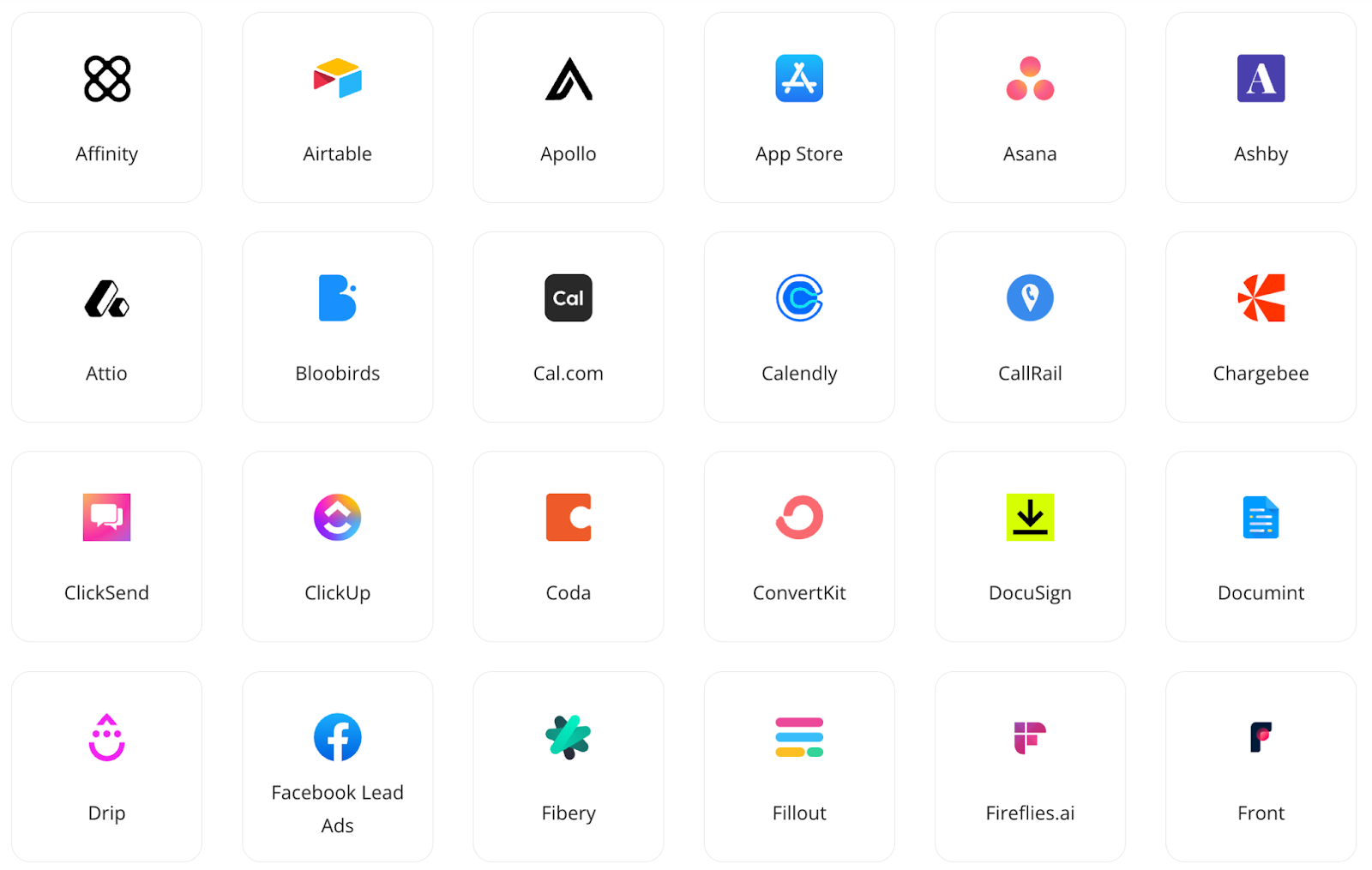
Our team is continuously expanding our integration offerings. If we don't currently have the integration you need, simply let us know, and we'll work on adding it to our library.
Zapier integrations
As one of the pioneers of workflow automation, Zapier has developed integrations with over 7,000 apps.
This lets you connect your tools and services, enabling seamless data transfer across your entire tech stack.
Zapier’s popular integrations include Slack, Trello, Google Sheets, Calendly, YouTube, ActiveCampaign, and more.
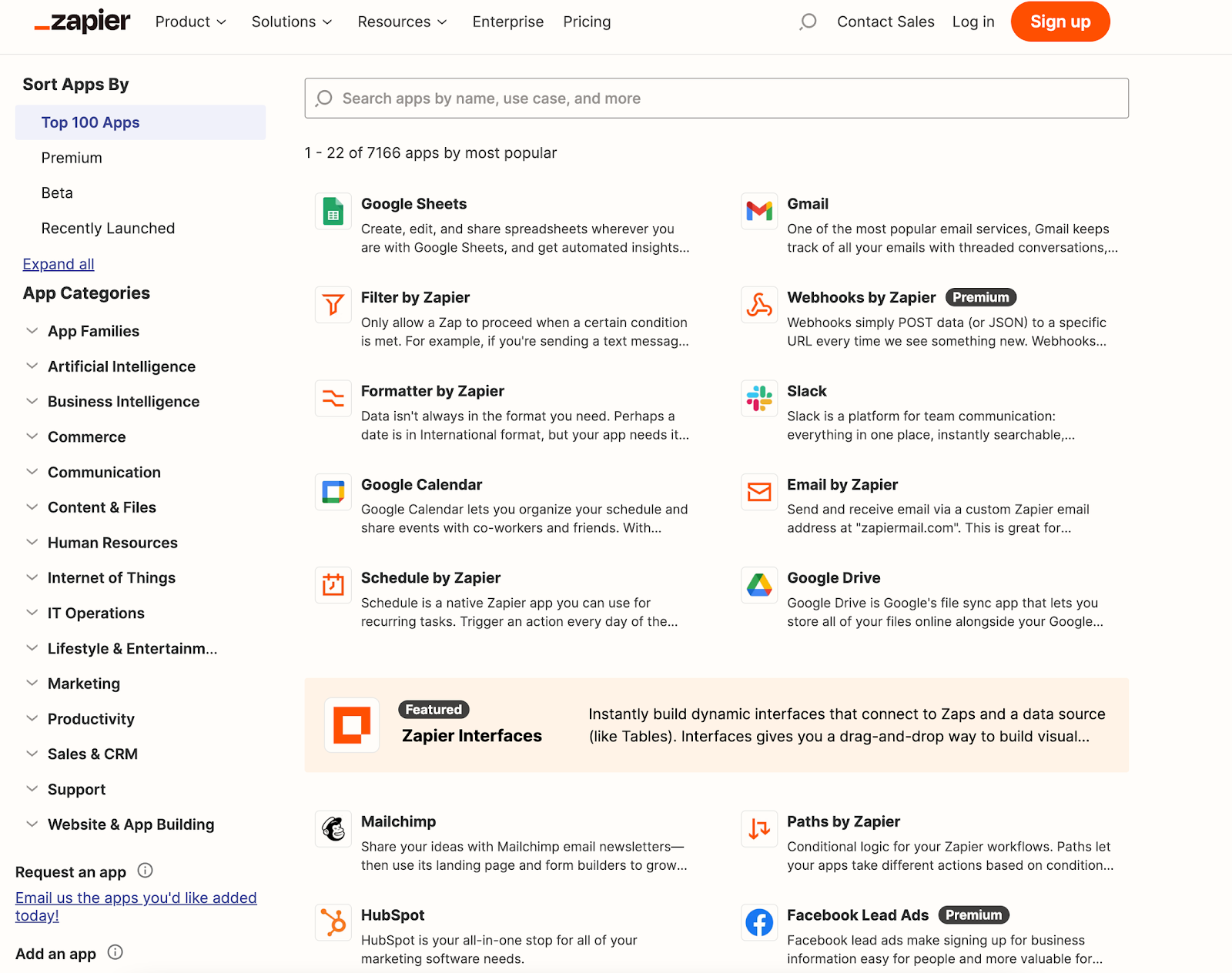
However, some apps are classified as premium and are only available with paid plans.
Pabbly Connect integrations
Pabbly Connect provides integration with up to 1,500 apps and services across categories including CRM, email marketing, cloud storage, e-commerce platforms, payment gateways, social media, and more.
Popular apps include Asana, Dropbox, Facebook, Google Contacts, Todoist, Typeform, Zoom, etc.
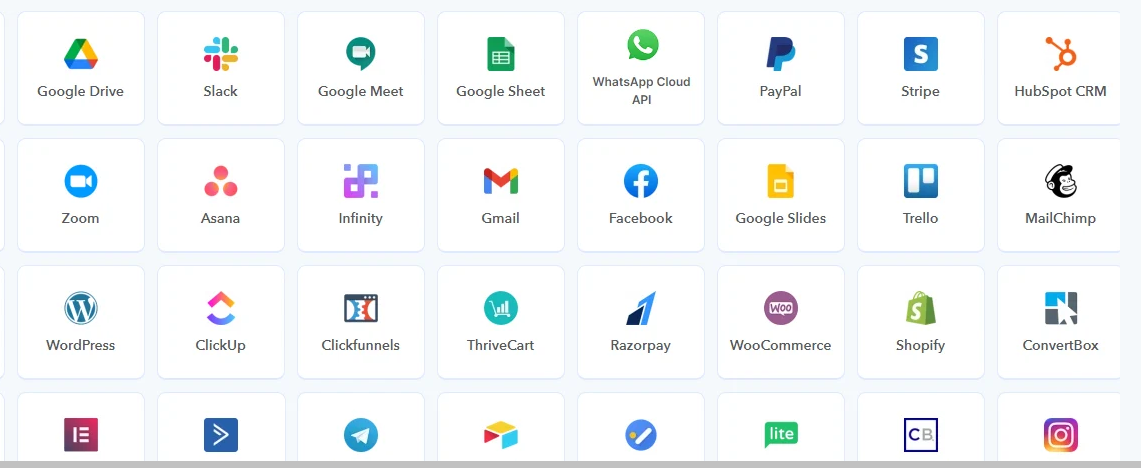
Who takes the integration trophy?
Zapier leads by a huge margin in terms of the number of integrations available.
But for ease of integration and accessibility, Relay.app and Pabbly Connect go shoulder to shoulder.
Pricing - Pabbly Connect vs Zapier vs Relay.app
Relay.app pricing
Relay.app offers a transparent pricing model based solely on seat numbers,enabling unlimited playbooks and runs without the need for workarounds to reduce execution, unlike Zapier and Pabbly Connect.
Plus, if you're a small business owner new to integration, you can sign up for free and enjoy 100+ runs, unlimited workflows, and one seat forever. If you need more, choose from these three annual plans:
Starter: $18/month for 2 seats, and unlimited playbooks, runs, and automation.
Team: $27/month for 3 to 20 seats, and unlimited playbooks, runs, and automation.
Enterprise: Custom pricing with unlimited users, unlimited automation, custom integrations, and priority support.
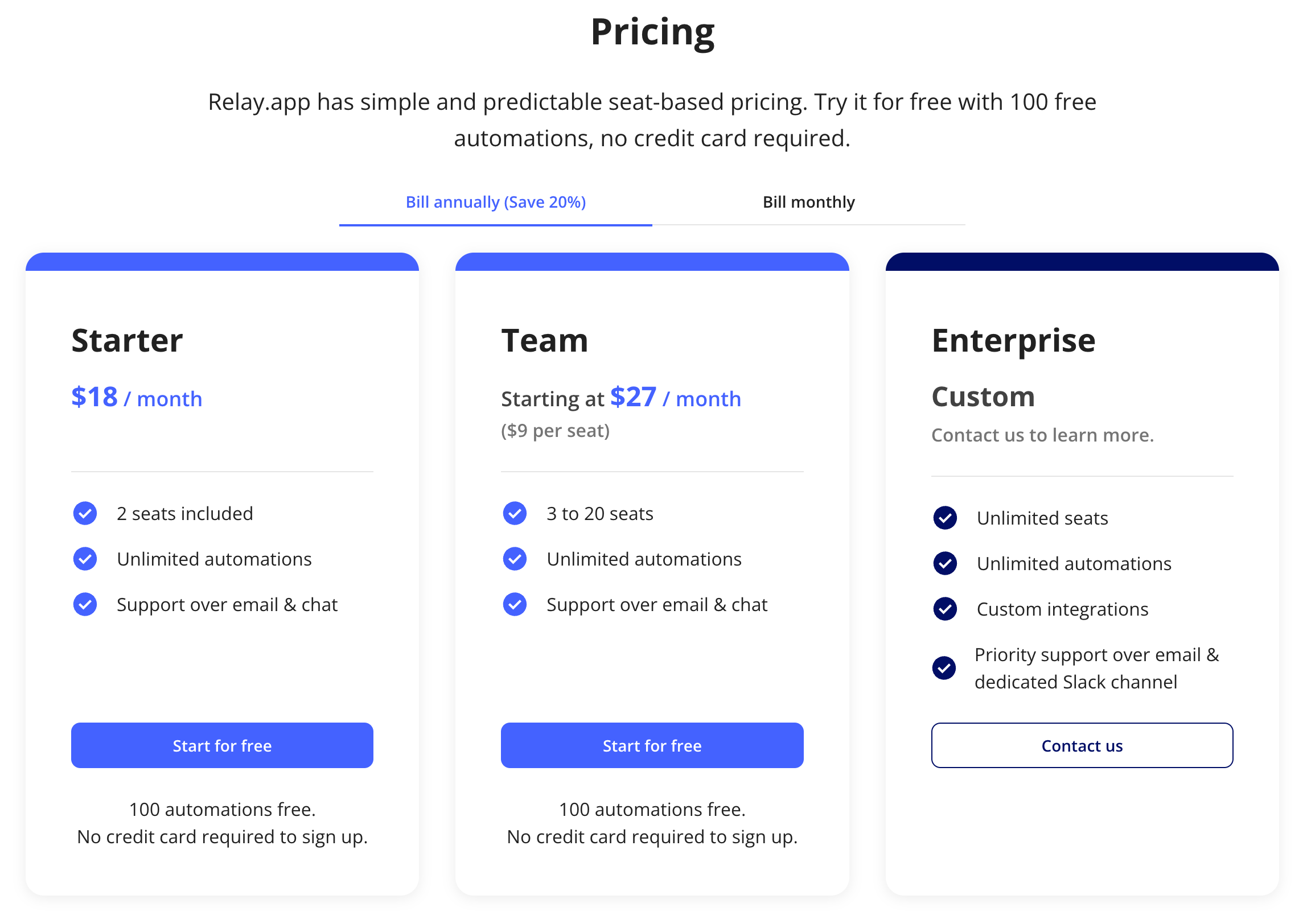
Zapier pricing
Despite recent pricing adjustments, Zapier remains the most expensive option compared to Relay.app and Pabbly Connect.
It charges based on tasks, with its free plan offering unlimited zaps but as low as two steps and limited access to premium apps.
Here are its three paid plans billed yearly:
Professional: $19.99/month
Team: $69/month
Enterprise: Custom pricing – contact sales

Now look at how fast Zapier's cost increases when volumes increase ⤵️
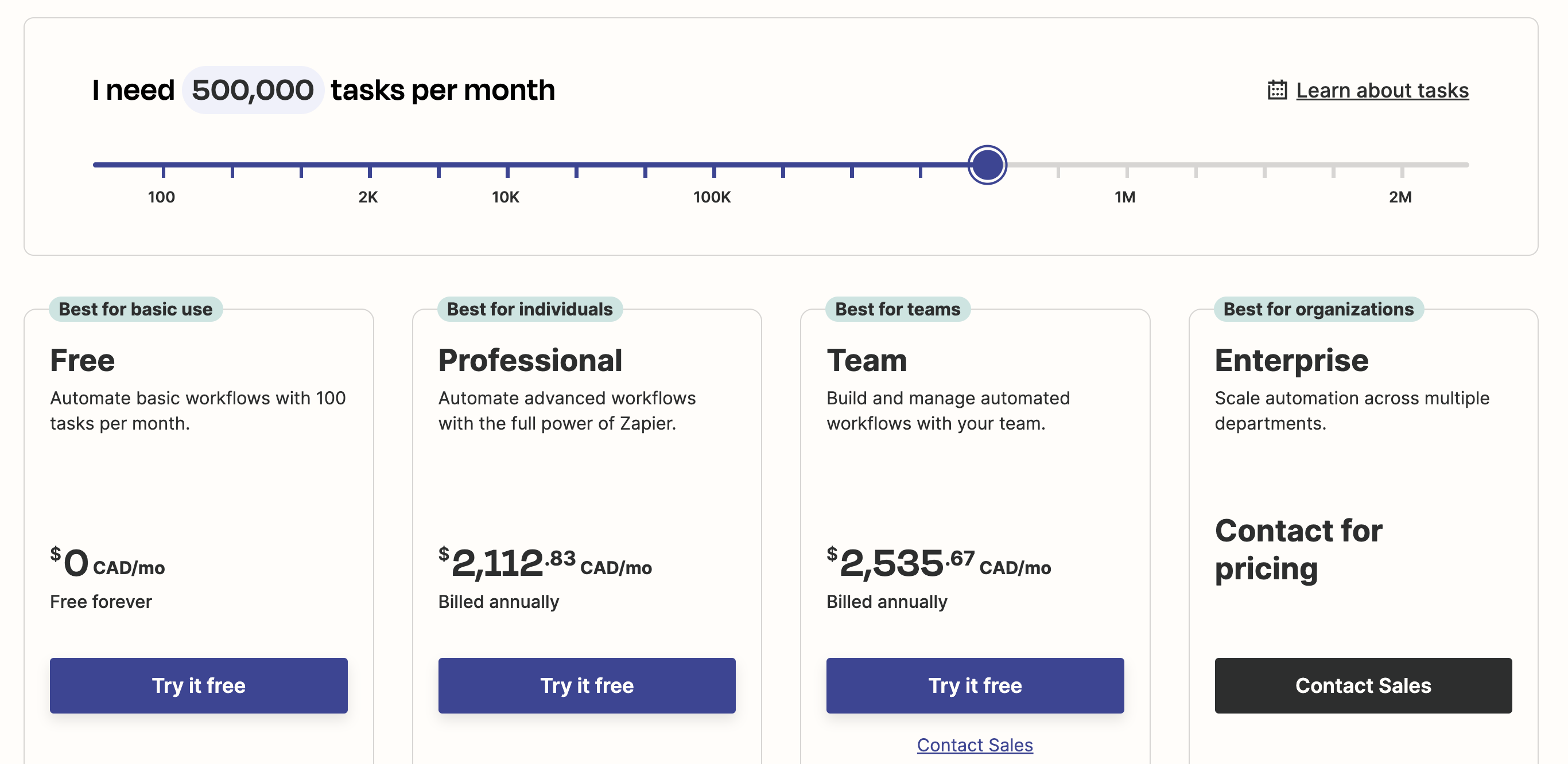
Pabbly Connect pricing
Pabbly Connect offers a free forever plan with unlimited workflows and team members. It also charges based on tasks like Zapier. However, it does not charge for internal tasks like filters, paths, and fixing data.
Here are its four annual plans billed annually:
Standard: $14/month
Pro: $29/month
Ultimate: Starting from $59/month, based on task execution
Enterprise: Contact enterprise team.
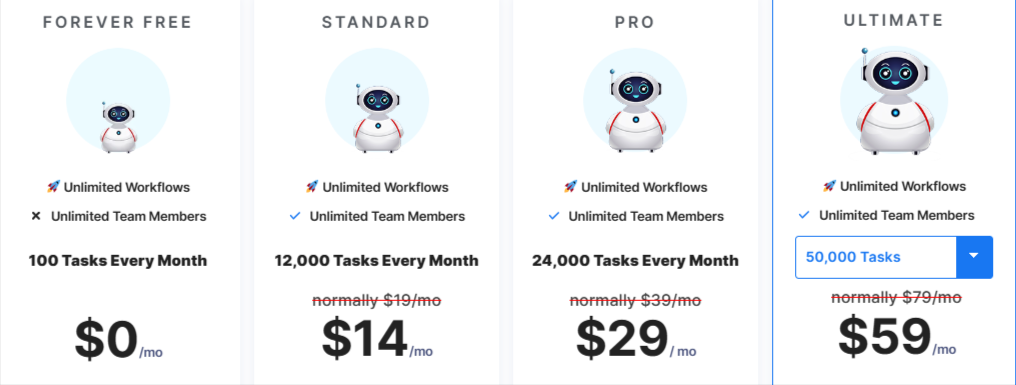
Users can also access Pabbly Connect lifetime purchase and a 30-day money-back guarantee.
Pabbly Connect’s plans are relatively cheap. However, if you’re running a large volume of tasks, Pabbly Connect can quickly become expensive.
In that case, Relay.app is an affordable and powerful option.
What are customers saying?
Here are reviews from real users of Relay.app, Zapier, and Pabbly Connect.
Relay.app reviews
For this user, Relay.app stands out for its exceptional customer support and superior user-friendliness compared to Zapier.
“The tool is flexible and powerful, allowing us to extend workflows in a lot of different directions. The team and support is great - they listen to our needs and help solve our problems quickly.
Best of all is the user-friendliness. Our team is lean. Relay.app is intuitive and allows all members of our team to build powerful automation so they can do more with less. Before Relay.app, we used Zapier which was good, but not nearly as easy, which prevented it from being rolled out broadly.” - verified G2 Review
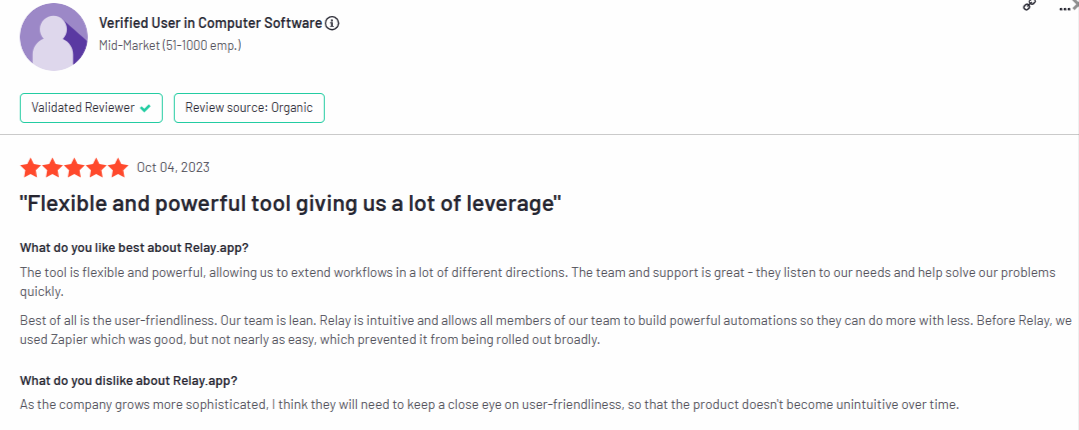
This user commends Relay.app for its rapid integration development and again, its excellent support.
“Their speed of developing new integrations, the existing set of integrations, their fast and human support, it saves us hours daily, it is also very simple to implement.” - verified G2 Review

Here's another user who chose Relay.app over similar apps for its great support, relevant integrations, and intuitiveness.
“I've been using Relay.app for over 6 months now and really pleased with the experience. I chose it over other similar apps because it offered the integrations I wanted and was much easier to get working. On top of that, the support from the Relay.app team has been great.”-verified Product Hunt Review

Zapier reviews
According to this user, although Zapier offers extensive pre-built integrations which increase the chances of automating all the apps used, not all the integrations work and the documentation is not very helpful.
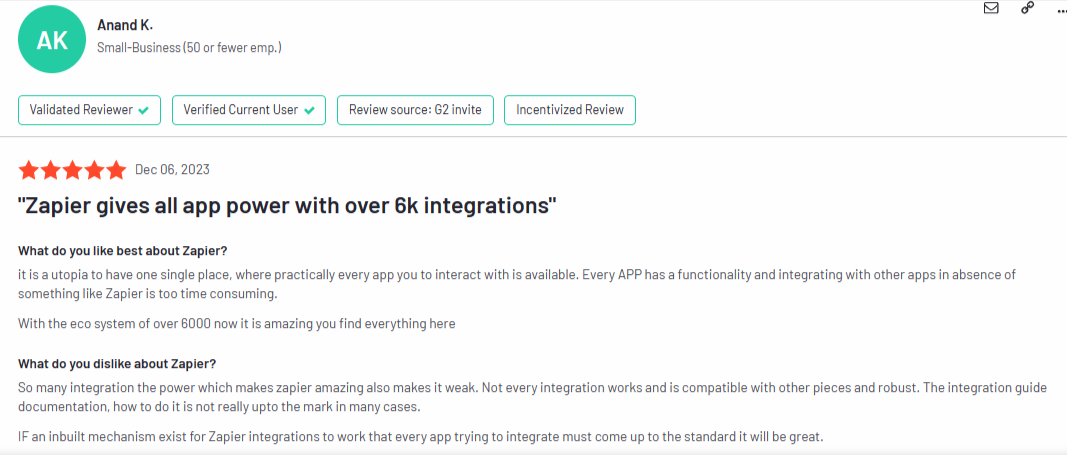
This Zapier daily user finds Zapier is great for its array of apps and ease of use. However, the automation is not reliable due to constant server error and customer support is difficult to reach.

Pabbly Connect reviews
While this user was happy with Pabbly Connect’s pricing, they didn’t find it intuitive for non-tech users.
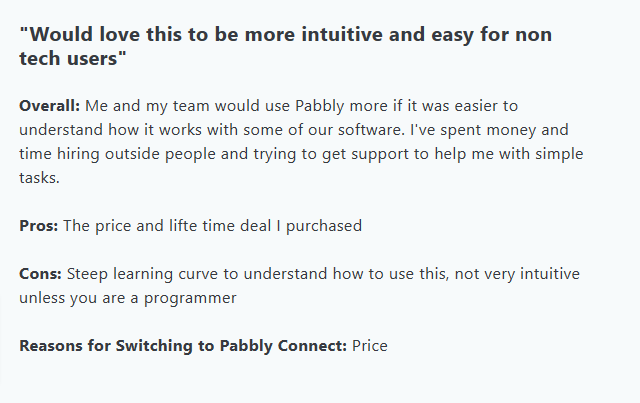
This user commends Pabbly Connect for its no-code approach, affordability, and array of integrations. However, besides its Facebook support, other forms of support are lacking. Also, its user interface is non-intuitive.
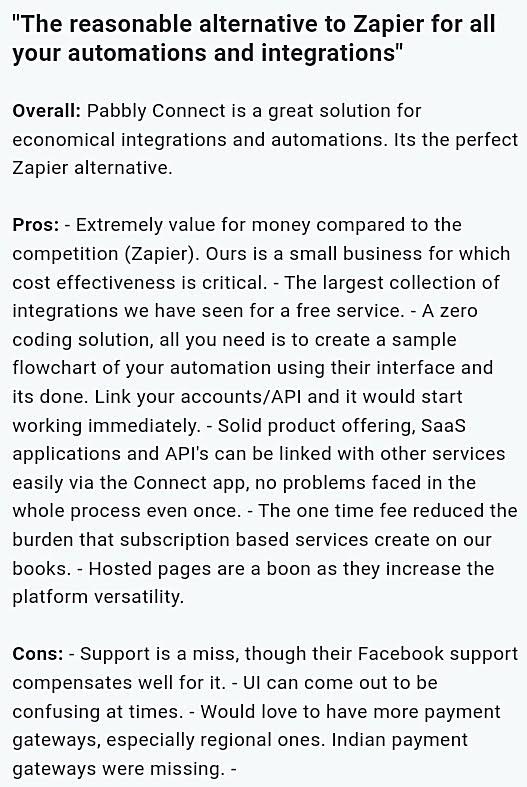
Next Steps
We believe that with this detailed comparison, you’ll be able to make the right choice that’ll suit your business needs.
Here’s a quick recap:
Relay.app stands unparalleled for innovative features which include:
- AI autofill, saving you time on manual data extraction and summary
- Human in-the-loop functionality which accommodates human judgment and input
- Collaborative workflow for transparent teamwork.
Zapier is excellent for creating complex and multistep workflows requiring intricate customization needs.
Zapier and Pabbly Connect have the most diverse range of integrations, though Relay.app is catching up quickly.
Pabbly Connect stands out for affordability.
Lastly, if you value world-class customer support that’s always ready to offer personalized help right on time, Relay.app has your back. Sign up for free – no credit card needed.

